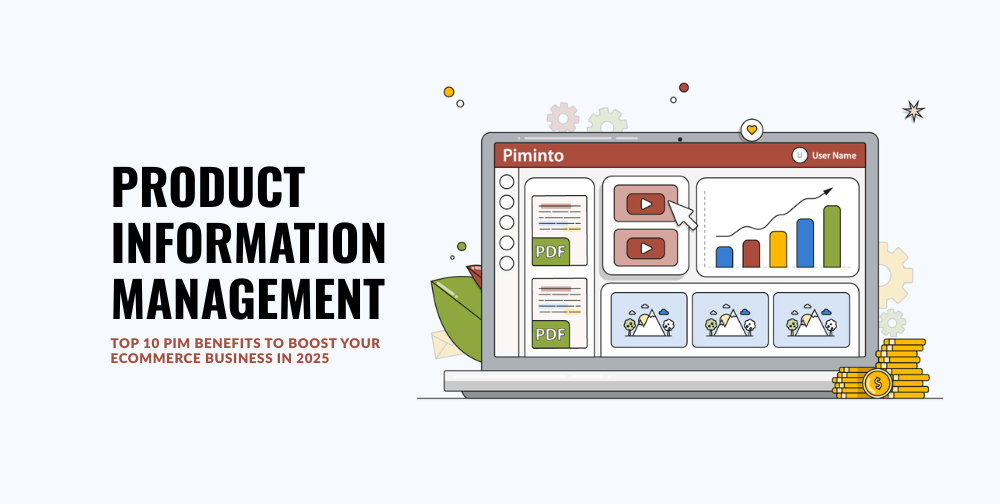Top 10 PIM Benefits to Boost Your Ecommerce Business in 2025

Managing product information has never been more challenging — or more critical. Customers shop across dozens of channels, regulatory requirements multiply, and competition intensifies. Today’s ecommerce leaders face unprecedented complexity. Yet those who master product data management don’t just survive; they thrive.
Product Information Management (PIM) systems transform how smart businesses handle their most valuable asset — product data. While competitors drown in spreadsheets and struggle with inconsistent information, forward-thinking companies use PIM to accelerate growth, slash operational costs, and deliver experiences that convert browsers into loyal customers.
What is a PIM Software?
A PIM system is the central hub for your product universe. This platform creates a single source of truth for all product information. It eliminate chaos across multiple systems, spreadsheets, and departments.
A PIM act as your digital product librarian. It organize everything from SKU details to technical specifications. It also manage marketing copy, pricing information, and rich media assets. You can manage fifty products or fifty thousand with a PIM. A PIM make sure every piece of product data is accurate, accessible, and ready for deployment across any channel.
For businesses wanting to explore what is product information management in greater detail, modern PIM platforms extend far beyond simple data storage. As brands, manufacturers, and retailers prioritize faster deployments and reduced IT complexity, cloud-based enterprise PIM platforms continue growing in importance through 2025 and beyond. Today’s PIM platforms incorporate artificial intelligence, workflow automation, and advanced analytics that transform raw product data into competitive advantages.
How can a PIM solution help your e-commerce business?
Imagine this situation: Your marketing team wants product descriptions for a new campaign. Your sales team needs updated pricing for a client proposal. Your ecommerce manager finds problems with inventory on three platforms. Without a PIM, this causes many emails, phone calls, and a lot of frustration that can last for hours or days.
A PIM for ecommerce stops these problems. It is the single place where all teams can find the same and up-to-date product information. Whether you have a Shopify store, sell on Amazon, or work with B2B clients, a PIM helps everyone follow the same plan.
The change occurs with easy PIM ecommerce connections. Modern PIM systems work with your current tools like ERP systems, ecommerce platforms, and marketing automation tools. This creates a system where product updates go automatically to every point. This is not only about being efficient; it is about finding growth chances that are impossible without managing data in one place.
10 Benefits of Integrating a PIM System
PIM systems deliver measurable business value across every aspect of your ecommerce operations. From accelerating product launches to building customer trust, each benefit compounds to create sustainable competitive advantages.
Here are the ten most impactful benefits that make PIM integration essential for modern ecommerce success. These aren’t theoretical advantages — they’re proven outcomes that successful businesses already leverage to dominate their markets.
1. Lightning-Fast Time-to-Market That Crushes Competition
In today’s fast business world, speed decides who wins and who loses. The luxury crystal brand Lalique cut product referencing time from eight hours every day to just two hours. This efficiency made their time-to-market much shorter, especially during busy times like Christmas.
Think about the numbers: Launching a new product usually needs information from six systems and five team members. This creates delays and mistakes and losses chances. A PIM changes this complicated process into a simple workflow. Product launches happen in days instead of weeks.
The advantages are more than just speed. Companies that use PIM can enter markets that they could not reach before. They can bring products to market four times faster on average. When seasonal trends change or competitors make quick moves, businesses with PIM systems benefit while other businesses struggle.
2. Data Quality That Builds Unshakeable Customer Trust
Bad product data hurts ecommerce sales. When customers see confusing descriptions or missing details, they lose trust quickly. This leads to them leaving their shopping carts.
Forrester research reports that businesses focusing on good data quality see a 20% rise in online sales. They also experience a 25% drop in product returns. This means they can earn millions more and save money on operations.
A PIM changes messy data into reliable data. It uses automated rules to check data, gets approvals for workflows, and keeps information organized. Each piece of product data gets checked for quality before customers see it. The result is product descriptions that attract buyers, specifications that help buyers, and consistency that turns unsure browsers into sure buyers.
3. Omnichannel Mastery Without the Complexity Headache
By 2025, omnichannel PIM is becoming standard practice. Companies manage product data for ecommerce sites, mobile apps, physical shops, and many marketplaces from one platform. This is not just a trend. It is the new reality of retail success.
Imagine you manage product information on your website, Amazon, eBay, and Facebook Shop. It can be hard with no PIM. You have to do many manual updates. This causes version control issues and inconsistencies.
PIM platforms remove this complexity. They have intelligent distribution capabilities. You update a product description one time. It automatically goes to all the channels with the right format and rules. Research shows that omnichannel campaigns have 287% higher purchase rates than single-channel campaigns. A PIM helps to achieve this performance without making things more complex.
4. Operational Efficiency That Liberates Your Team
Manual data entry reduces productivity for modern businesses. Each hour spent copying product information is an hour not spent on important growth tasks.
The luxury crystal brand Lalique cuts daily product referencing time from 8 hours to 2 hours with Quable’s PIM. De Neuville gets a full-time employee by switching to a PIM system. These efficiency gains reduce costs and open up human potential.
Think about the effects. Marketing teams can focus on creative campaigns. Product managers can analyze market trends. Sales teams build relationships instead of looking for current pricing. A PIM does not just help efficiency; it changes job satisfaction and strategic ability.
5. SEO Performance That Dominates Search Results
Standing out in search engine results challenges every ecommerce business. Search engine optimization requires consistent, accurate, and comprehensive product information across every page and platform.
A PIM supercharges SEO performance through several mechanisms. First, it ensures every product page contains complete, keyword-rich descriptions that search engines favor. Second, it maintains consistency across all channels, building domain authority and reducing duplicate content issues. Third, it enables rapid updates when SEO strategies evolve or market conditions change.
The benefits compound over time. Products with better visibility drive more organic traffic, generating more sales, which improves search rankings in a virtuous cycle of growth. With improved organization of your product data through a PIM, search engine algorithms better understand product information on your website.
6. International Expansion Made Simple
Expanding globally should not cause many problems. However, many businesses find it hard to manage product information in different languages, currencies, and rules. This complexity can slow down growth.
PIM software for ecommerce makes international expansion easier. It changes a big challenge into a simple process. The software has built-in features for localization and automated translation workflows. It also helps with managing compliance. PIM platforms help businesses enter new markets quickly without increasing operational workload too much.
Think about the other option. Manual translation of many product descriptions is very hard. Changing prices for different regions and checking compliance takes a lot of time. A PIM automates these tasks. It keeps accuracy and consistency that helps customers trust businesses in new markets.
7. Revenue Growth Through Enhanced Customer Experience
Every time customers look at your product information, it affects their buying choice. Incomplete descriptions make customers hesitate. Inconsistent pricing makes customers suspicious. Outdated specifications lead to returns. Poor product data not only costs sales but also harms brand reputation.
Correct product information in your store helps customers buy faster. When there is a lack of information or other details that do not match, it can slow down or stop customers from buying.
A PIM makes better customer experiences. It gives complete, correct, and interesting product information. Customers find the details they need. They trust the information they get. They feel confident when they buy. This leads to better conversion rates, higher average order values, and more customer lifetime value.
8. Scalability That Grows With Your Ambitions
Small businesses can manage dozens of products with spreadsheets and manual processes. But growth changes everything. Adding new product lines, expanding into additional channels, or increasing team size quickly overwhelms manual systems.
PIM platforms provide the scalable foundation that supports exponential growth without exponential complexity. Whether you manage hundreds or hundreds of thousands of SKUs, modern PIM systems maintain performance and usability. PIM provides the scalability and flexibility needed to manage expanding product ranges and enter new markets.
The scalability extends beyond product volume. PIM systems accommodate growing teams through sophisticated user management, expanding channels through flexible integration capabilities, and evolving business requirements through configurable workflows and automation rules.
9. AI-Powered Innovation That Future-Proofs Your Business
AI-powered PIM systems play a key role in ecommerce by 2025, with a strong focus on efficiency. A Gartner survey highlights Product Information Management as a top AI use case for high-growth companies. This isn’t science fiction — it’s today’s competitive reality.
Modern PIM platforms incorporate artificial intelligence for content generation, data enrichment, quality assurance, and predictive analytics. In 2025, AI assistants and agents automate repetitive PIM processes extensively, including data enrichment, translations, quality checks, and taxonomy management.
Imagine AI automatically generating product descriptions based on specifications, identifying missing information before it impacts sales, or suggesting optimal content for different customer segments. These capabilities don’t replace human creativity — they amplify it by eliminating routine tasks and providing intelligent insights.
10. Measurable ROI That Justifies Every Investment Dollar
The ultimate question for any business investment is simple: Does it generate more value than it costs? For PIM systems, the answer is increasingly clear through multiple revenue streams and cost reductions.
Revenue increases come from faster time-to-market, improved conversion rates, enhanced SEO performance, and successful international expansion. Cost reductions emerge through operational efficiency, reduced returns, eliminated errors, and team productivity gains. The benefits of a PIM extend to your customer experience, your team’s efficiency, and key ecommerce metrics like conversion rates.
The ROI calculation becomes more compelling when considering opportunity costs. Every day without a PIM is a day of missed sales, wasted effort, and competitive disadvantage. Early adopters gain sustainable advantages that compound over time, while late adopters face ever-increasing implementation complexity.
Optimize Your Business Today with Our PIM Solution
The evidence is overwhelming: Product Information Management isn’t just beneficial — it’s essential for ecommerce success in 2025 and beyond. Companies that master product data management gain decisive advantages in speed, efficiency, customer experience, and growth potential.
But transformation doesn’t happen overnight, and it doesn’t happen by accident. Successful PIM implementation requires strategic planning, careful vendor selection, and commitment to change management. The businesses thriving today didn’t wait for perfect conditions — they took action when the opportunity became clear.
The opportunity is clear now. Organizations that invest in robust PIM systems position themselves to deliver the personalized experiences that customers increasingly demand, expand rapidly into new channels and markets without data management bottlenecks, and optimize operational efficiency in product content creation and distribution.
Your competitors are already adopting PIM systems. Your customers are already demanding better product experiences. Your team is already struggling with manual processes that limit growth potential. The question isn’t whether you need a PIM — it’s how quickly you can implement one that transforms your business trajectory.
Don’t let another day pass without taking action toward PIM implementation. Your future success depends on the decisions you make today. Make them count.





